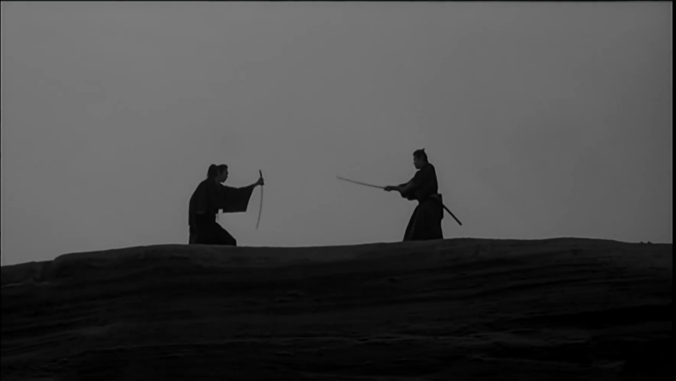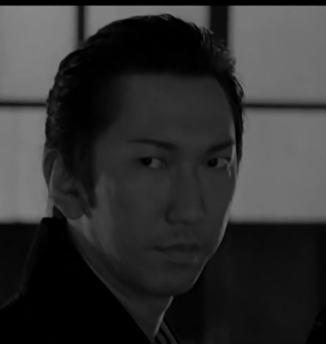 While period movies appeared in the nineties, the old-fashioned chanbara was scarce on the ground, still for the most part the province of television. Samurai Fiction is a playful salute to the old-style chanbara, not quite parody or satire but still not to be taken as an attempt at a serious revival of the genre.
While period movies appeared in the nineties, the old-fashioned chanbara was scarce on the ground, still for the most part the province of television. Samurai Fiction is a playful salute to the old-style chanbara, not quite parody or satire but still not to be taken as an attempt at a serious revival of the genre.
Rather than focus on any particular movie as a source, the screenplay by pinku veteran Hiroshi Saito and first time director Hiroyuki Nakano condenses the whole genre as it was known in the fifties and sixties. We start with one of the most traditional situations: A clan treasure — a sword personally presented by Tokugawa — has been stolen and must be retrieved to save the honor of the clan and of a young samurai’s family. This of course leads to a ronin on the road pursued by the hot-headed young samurai and his friends, with a couple of ninjas thrown in for good measure. Along the way we meet a female yakuza boss trying to take over another gang’s territory, a ronin who gave up the samurai life to raise the daughter of the man he killed, a romance, the substitution of a fake sword, a challenge to a dojo, crooked dice games, and even a blind masseur (he walks unharmed through a fight but uses no cane sword). Surprisingly, the one traditional scene we do not see is the swordsman surrounded by a dozen or more men in a circle, nor is there some secret “style” of swordplay.
Though there are visual jokes a-plenty, this is no Blazing Saddles satire. Rather than specific scenes from any one movie to be parodied, we see an amalgamation of all the movies in the genre. The jokes are gentle and good-natured.
The young samurai Inukai and his two friends are called the Three Stooges by the rest of the clan, and they exhaust themselves on the road by trying to outrun the other while chasing Kazamatsuri, the ronin with the sword. The aide to Inukai’s father is an old ninja who keeps dropping from the ceiling because he can’t break the habit, yet always lands off-balance. Inukai is wounded and nursed by Oharu, and whenever he gets the slightest glimpse of her bare skin he gets a nosebleed. The dojo teacher gets a sudden cough after Mizoguchi defeats all his disciples, leading to a payment instead. Mizoguchi gives lessons to Inukai not in sword-fighting but in rock-throwing, at which Inukai is initially a disaster.* When told to throw lower, he kneels. The ninjas are no more competent than Inukai and his one friend who dies is actually killed by an innaccurately thrown shuriken. Kazamatsuri took the sword almost by accident, doesn’t care about it at all, and would happily give it away or give it back if Inukai would just ask rather than try to avenge the clan’s honor in a fight. The retired samurai is named Mizoguchi, his daughter Oharu, the female gambling boss Okatsu, a samurai is called Suzuki and a minor ronin is Kurosawa, but there are no specific references to any of their movies.
Like the classic chanbara of the past, the movie is mostly in black and white, though it looks suspiciously like a color film with its color digitally removed. It is also bloodless, with the deaths in the swordfights depicted with a red color filter over the shots of falling bodies, usually in slo-mo as well. Given the date, it surprisingly foregoes any nudity, with only Oharu’s calf seen as she washes her feet, but then the old chanbara had no nudity either.
This is still a movie from the nineties – the music is mostly electric guitar provided by the famous rock guitarist Tomohasu Hotei, who also played Kazamatsuri, with a visiting musician thrown in to perform “Swanee River” on a saw and the seventies “Dance with Me” accompanying a dance by Okatsu at a party. For the most part this works, underlining the playful tone of the rest of the presentation. Perhaps because the cast are not swordplay veterans by any stretch of the imagination, the actual fights are quite limited in scope, even inside the dojo, and some of the more traditional face-offs are done in silhouette, suggesting stuntmen rather than the performers themselves.
who also played Kazamatsuri, with a visiting musician thrown in to perform “Swanee River” on a saw and the seventies “Dance with Me” accompanying a dance by Okatsu at a party. For the most part this works, underlining the playful tone of the rest of the presentation. Perhaps because the cast are not swordplay veterans by any stretch of the imagination, the actual fights are quite limited in scope, even inside the dojo, and some of the more traditional face-offs are done in silhouette, suggesting stuntmen rather than the performers themselves.
Some versions call this “Episode One,” though as far as I can find no such sequel was made. If so, it would have had an entirely different set of characters, all of whom are seen in a final Happy Ending, except for Kazamatsuri. His disappearance at the end is just nebulous enough to leave a sequel open, just as with so many of the old series films.
* This is a typical scene borrowed from the American Western, where the young man is taught to use a gun, with bottles and stones to throw at rather than shoot at. My mind keeps envisioning a chanbara in which the swordsman is attacked by someone throwing rocks, but the one example I can actually place is in a Western, Support Your Local Sheriff, in which James Garner chases a hired gun out of town by throwing rocks at him.



Watching the movie reminded me of the first time I saw John Belushi’s samurai parody on SNL back in 1975. Similar to Belushi, Hiroyuki Nakano captured the essence of chambara in a perfectly humorous way. The film was successful enough on a limited budget that Nakano was rewarded with a larger budget to make 2001’s colorful “Red Shadow” (Akakage).
LikeLike
Pingback: Cabaret / Kyabare* (1986) | Japanonfilm
Pingback: Red Shadow / Akakage (2002) | Japanonfilm